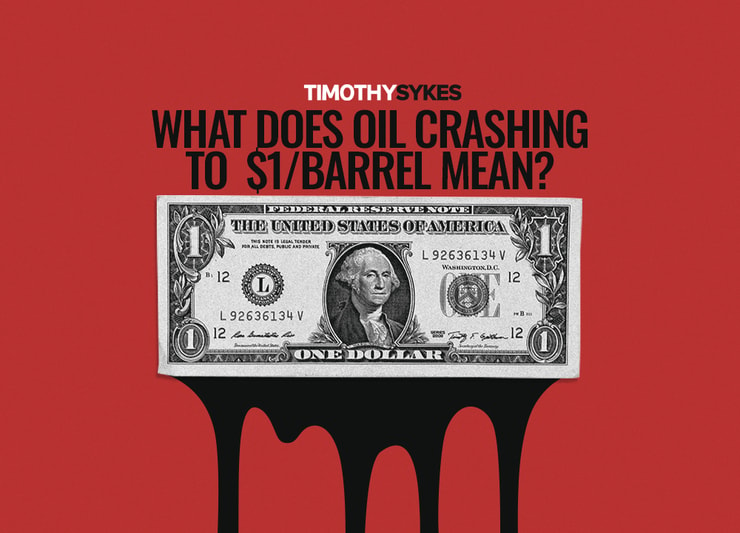Yesterday, April 20, oil futures went negative for the first time in history. I’m getting a lot of DMs and emails asking, “What does this mean?”
WOW, Oil Futures Fall Below $1 for First Time Ever….crazy times right now, stay safe and realize ANYTHING can happen!
— Timothy Sykes (@timothysykes) April 20, 2020
So I want to explain the oil crash in layman’s terms. Then I’ll explain what it means for my niche, penny stocks. And why it’s imperative you prepare now for more market volatility.
Table of Contents
How Did the Oil Crash Happen?
Like the rest of the economy, the oil crash has one underlying factor: the coronavirus pandemic.
But to simply blame it on the coronavirus doesn’t provide enough context. If you’re gonna prepare for more market volatility, it’s good to have a basic idea of how this all played out.
Supply vs. Demand
When it comes to oil prices, the bottom line is supply vs. demand. If there’s more supply than demand, prices drop. If there’s more demand than supply, prices rise.
Right now, there’s very little demand for petroleum. And there’s a huge oversupply. Let’s take a look at those one at a time.
We’re under shelter-in-place orders. So fewer people are driving fewer miles. Even those still hopping in their cars to go to work aren’t driving as much. Very few people are driving any distance for recreational purposes.
It’s estimated that demand for gas has dropped 50% in the past month. Demand for gasoline in the U.S. is at its lowest in decades. The Energy Information Administration only publishes data back to February 1991 on its website. Gas demand is at the lowest ever in that time.
And it’s not just gasoline…
Fewer people are flying. Jet fuel consumption dropped by an estimated 70% over the same period. Airlines have parked planes and all but stopped flying.
Let’s look at the numbers: TSA checkpoint travel numbers for April 19 show 105,382 passengers. Compare that to a year ago when 2,356,802 people passed through TSA checkpoints. That’s a 95% drop in passenger air travel.
On top of lower demand, there’s a glut of oil due to…
Price Wars
OPEC and several non-member countries agreed earlier this year to cut production. Their goal was to prop up worldwide oil prices.
Then, in early March Russia disagreed with Saudi Arabia and OPEC on oil production limits. So Saudi Arabia increased production and started a price war.
Here in the U.S., domestic production hit record levels in February and continued into March.
The combination of the price war, record levels of U.S. production, and the drop in demand has done one thing…
Oil Storage Facilities Filled to the Brim
There’s only so much capacity to store oil. In the U.S., our biggest storage facility is located in Cushing, Oklahoma.
The oil tanks there can hold roughly 76 million barrels of oil. It’s estimated those tanks will be full by the end of April. It’s virtually impossible to lease unfilled tanks — they’re already taken.
So too much oil, far less demand, and no place to store the oil pumped today all led to yesterday’s historic situation.
Oil Crash: Futures Drop to –$37 Per Barrel
The May contract for West Texas Intermediate (WTI) crude went negative for the first time in history. What does it mean?
It means traders holding contracts for May delivery were paying other traders to get the contracts off their hands. Without a place to take delivery of 1,000 barrels of oil, you don’t want to be holding a contract when it stops trading.
No storage led to panic selling…
But it’s not the end of the world as @goodetrades says: Don’t overthink oil going negative, today’s last day for it to trade & those long the contract at day’s end will have to take delivery, there isn’t any excess storage left, so people long the futures contract MUST panic sell
— Timothy Sykes (@timothysykes) April 20, 2020
Still, all this is leading to…
Turning Off the Spigot
Oil producers have little choice but to cut production until demand ramps up again. It’s anybody’s guess when that will happen. Even as states like South Carolina, Tennessee, and Georgia announce plans to ease their economies back into action…
… it could take months before oil demand hits pre-pandemic highs.
As of today, oil futures trading rolled over to contracts for June delivery. As I write, they’re trading in the $11s — down roughly 45% on the day. So the oil crash is far from over.
One thing to consider…
There’s a floor price for oil. That’s the lowest price per barrel producers can afford. Below the floor, they’re losing money. Even at $30 a barrel, oil is priced at the floor for some of the best-positioned producers. For others … $50 a barrel is more realistic.
So June contracts trading in the $11s is bad news for the oil industry.
Oil Well Shut In
In the oil and gas industry, to shut in a well means to close it off so it stops producing. And that’s pretty much where the U.S. oil industry is headed. Low demand and no excess storage capacity means they’ll have to turn off the spigot and hunker down.
Until demand returns, it’s likely oil will remain somewhere in the single digits to low $20s.
So you might be wondering … what’s the big deal, right? The oil industry is full of very rich people, right?
Well, yes and no.
Oil requires a lot of up-front investment. So while the U.S. is the world’s top oil-producing country, there’s massive debt. A lot of the shale industry ramped up when oil and gas prices were much higher and financing debt was cheaper. This crash could be more than a hunker-down time for U.S. petroleum companies. There will be bankruptcies.
It might seem cool to see gas prices so low — and to know they’ll likely drift lower in the coming months. But also understand how much the economy relies on our ability to move people and products around. Right now, not much is moving.
What Does the Oil Crash Mean for Penny Stock Traders
First, let’s get one thing very clear…
Oil futures going negative for the first time in history is the latest example of how ‘off’ the markets are.
We’re in unprecedented territory on many levels. The world economy has, for all practical purposes, shut down voluntarily. The underlying factors in the economy were pretty strong before the pandemic.
We crashed the economy to flatten the curve.
The problem is…
… projecting the knock-on effects into the future … we have no idea how long it will take to recover. And I don’t like to guess.
Plus, the amount of money spent to develop a vaccine pales compared to what we’re throwing at the economy to prop it up.
I’m all for helping the little guy & small businesses, but THE BEST help will be finding a vaccine & better testing ASAP, so that’s what we should all be focusing on, right? It blows my mind the $ being spent & wasted as this crisis drags on longer & longer, we must spend better!
— Timothy Sykes (@timothysykes) April 21, 2020
I’d been saying for months that we were due a market correction. We got a market crash. But the longer the pandemic wreaks havoc on the economy, the closer we get to a long and drawn-out recovery.
What I can tell you is…
This Is a Time of Extreme Volatility
Which is actually an opportunity for traders who are prepared. It means more volatile opportunities that can move faster.
Recently, I put together a no-cost two-hour guide called “The Volatility Survival Guide.” At the time I had no idea we’d see an oil crash like this.
But the overall market has been volatile since late February when it finally took notice of the coronavirus. Things really got volatile in early March with the coronavirus-induced selloff. That’s why I created the guide.
Based on what’s happening in the stock market today … it’s imperative you watch it.
Access the FREE “Volatility Survival Guide” Here
Bears vs. Bulls
When the longest bull market in history came to an end in March, what followed was a crazy period. Wild swings. Huge up days followed by just as big down days. If you look at a Dow chart, it looks very similar to the price action leading to the Great Depression.
Over the past couple of weeks, the market bounced back. Some people even tried to call it the shortest bear market in history. My take on it is this…
It doesn’t matter.
What you should focus on is all the opportunities in the market right now. And with most of us still under shelter-in-place orders, it’s an ideal time to study. Again, I don’t like to predict the market.
And it doesn’t matter what I think is gonna happen. Nor does it matter what the bald guy on financial TV thinks is gonna happen.
What’s important is that you…
Prepare to Take Advantage of Volatility
This market — and this oil crash — is crazy. And based on what I’m seeing from the government…
… spending billions to prop up businesses but…
… only a few billion to develop a coronavirus vaccine…
… it could stay crazy for a while.
So again, it’s imperative you spend time studying. What should you be learning?
How to Spot Opportunities and Stay Safe
The patterns I’m trading aren’t anything new. I’ve been trading the same patterns for two decades. And teaching them for ten years. But you MUST prepare to take advantage of them.
Embrace the Volatility
Every day I get questions from students and non-students alike…
“Tim, how did you pick that supernova? How did you know it would spike 50%?”
The answer: by studying and from experience. I don’t know how much a stock will spike. But I know what types of catalysts spike stocks. And I recognize patterns. The past four weeks we’ve seen so many supernovas, it’s hard to keep track.
And today we saw another supernova. Again, it’s nothing new. You can learn this. My question is … are you willing to put in the time and effort to do so?
Lots of questions about how I picked Supernovas like $WATT so please watch this FREE webinar: https://t.co/yvxbpfZVob this strategy has been on fire the past 4 weeks with 50-100%+ wins on $BMRA $WORX and $AKER too, whewww, what a crazy #coronavirus market! #embracevolatility
— Timothy Sykes (@timothysykes) April 21, 2020
Supernova Alerts is my latest newsletter. So far it’s been a huge success. So if you want to learn the supernova pattern and potentially benefit from my alerts…
Watch the FREE Webinar Here
Now Is Your Time

This market is ‘off’ in so many ways. But at the same time the patterns I’m trading … the patterns my students are trading … they’re the same.
The big difference is there are so many opportunities right now I can’t keep track. A few weeks back I wrote about it being a ‘fire at will’ market. I don’t often use that term, but right now it applies.
But you can’t just trade random spiking stocks or take big position sizes. You gotta work on the process and learn to be meticulous. You MUST learn rule #1: cut losses quickly. Ready to learn smarter rules for dealing with a volatile market? Learn more in my Trading Challenge.
My goal is to teach traders to think for themselves, be self-sufficient, and trade through anything. Apply today — if you’re prepared to work your butt off.
I’ll ask again: are you ready? Is now your time? Every day we’re seeing examples of the patterns I teach. It won’t last forever. Yes, there will always be opportunities. But the market is giving us the opportunity to compress time by throwing example after example at us.
What does oil crashing to $1 a barrel mean? More volatility … and more opportunity. Don’t pass it up.
What do you think of the oil crash and market volatility? Comment below, I love to hear from all my readers!




Leave a reply